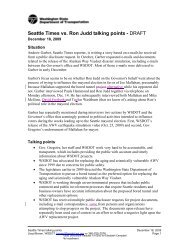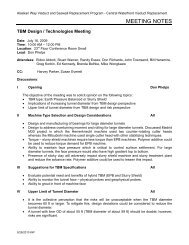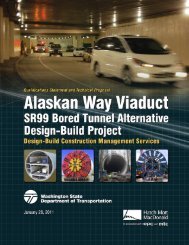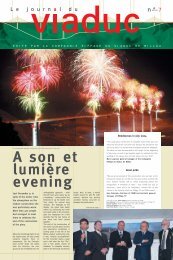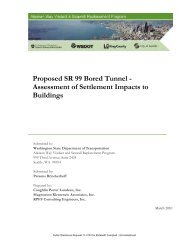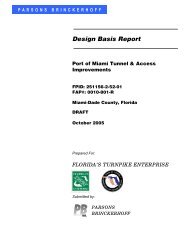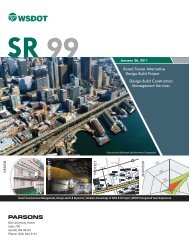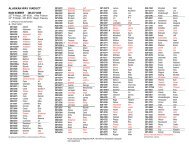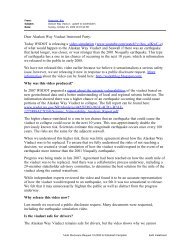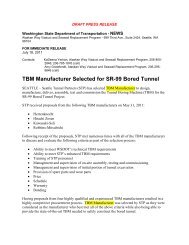herrenknecht ag softground tbms > 40 ft - SCATnow
herrenknecht ag softground tbms > 40 ft - SCATnow
herrenknecht ag softground tbms > 40 ft - SCATnow
You also want an ePaper? Increase the reach of your titles
YUMPU automatically turns print PDFs into web optimized ePapers that Google loves.
Large diameter EPB machines, and very large diameter<br />
EPB machines such as the one used on the<br />
south bypass tunnel for M30, require a very high cutting<br />
wheel torque compared for example to slurry<br />
TBMs.<br />
Machine technical and process technical factors<br />
such as drive unit and bearing unit, cutting wheel<br />
design and rotational speed have a relevant effect on<br />
the torque of the cutting wheel.The EPB-Shield for the<br />
Calle M30 project has a very high cutting wheel torque<br />
which amounts to 125,000 KNm.Therefore the cutting<br />
wheel is equipped with two concentrically arranged<br />
cutting wheels.<br />
The inner cutting wheel is installed in the free centre<br />
of the outer cutting wheel as a flat disc-type wheel. It<br />
is installed in the working surface of the outer cutting<br />
wheel and it is longitudinally displaceable relative to<br />
the outer cutting wheel.<br />
The rotational drives of both cutting wheels<br />
are completely independent with different rotational<br />
speeds in both directions of rotation.<br />
Part of the high torque is consumed in the mixing<br />
chamber, which is neutral with respect to the rolling<br />
of the machine. The torque is consumed between the<br />
cutting wheel and the tunnel face, it is the active part<br />
regarding the rolling of the TBM and can be resisted in<br />
loose soil by means of the skin friction or by transfer<br />
into the tunnel lining (reinforced concrete segments).<br />
If the torque rises beyond the value which can be<br />
resisted by the moment of friction of the shield shell,<br />
the machine will show a tendency to roll.<br />
With a diameter of 15.2 m and a torque of<br />
125,000 kNm the Herrenknecht EPB Shield beats all<br />
dimensions which have up to now been available on<br />
the mechanised shield tunnelling market.<br />
The drive unit of the inner cutting wheel comprises<br />
10 motors with a total power of 2,000 kW. To summon<br />
up the required power of 12,000 kW for the outer cutting<br />
wheel a new design was conceived. Altogether 50<br />
motors are necessary for the outer cutting wheel drive.<br />
They have been distributed around the main drive in<br />
two rows of 29 motors and 21 motors.<br />
The double cutting wheel design also improves<br />
the excavation process and the soil conditioning. The<br />
material excavation in the outer and inner area of the<br />
tunnel face can to a large extent be carried out at<br />
an optimised cutting tool speed. This is achieved by<br />
adjusting the differences in peripheral speeds, which<br />
can be applied to the cutter tools.<br />
The design of the outer cutting wheel area facilitates<br />
the arrangement of various cutter positions, which is<br />
normally not possible at all in the inner area as a<br />
favourable opening ratio must be maintained. A great<br />
difference in the cutter penetration depth between the<br />
outer and the inner area can be avoided by a higher<br />
rotational speed in the inner area, which has also the<br />
effect of reducing wear on the cutting tools.<br />
With regard to the soil conditioning with the double<br />
cutting wheel design and in particular with respect<br />
to the material removal and kneading or mixing<br />
effect, the mixing chamber can be divided into two<br />
zones. Both can be handled independently from each<br />
other.<br />
The areas of the inner and outer mixing chamber are<br />
in direct contact with each other so that an exchange<br />
of material between both zones is possible but not necessary.<br />
Because of the individual handling of the outer<br />
and inner mixing chamber, a homogenous consistency<br />
of the material in the chamber can be achieved.<br />
The cutting wheel is equipped with eight independent<br />
injection points at the front face of the centre<br />
cutting wheel and with 14 independent foam lances<br />
installed in the outer cutting wheel. Thus the injection<br />
of plasticizing <strong>ag</strong>ents such as foam is possible.Thereby<br />
36% of the total volume will be injected through the<br />
injection points, which are provided on the front face<br />
of the centre cutting wheel and the remaining 64% will<br />
be injected in the outer ring section.<br />
The start-up of the excavation process of the currently<br />
largest EPB-Shield begins when the inner cutting<br />
wheel starts rotating. The soil will be conditioned<br />
with foam through the rotary union, which is attached<br />
to the centre cutting wheel and above the stators. The<br />
stators are positioned in the centre area behind the cutting<br />
wheel in order to reduce the friction on the inside.<br />
To increase the mixing effect in the centre area, the<br />
displacement cylinders will be slowly extended.<br />
Figure 1. Injection of plasticizing <strong>ag</strong>ents through the two<br />
concentrically arranged cutting wheels of the EPB-Shield<br />
(Ø15.2 m) for M30.<br />
1170




